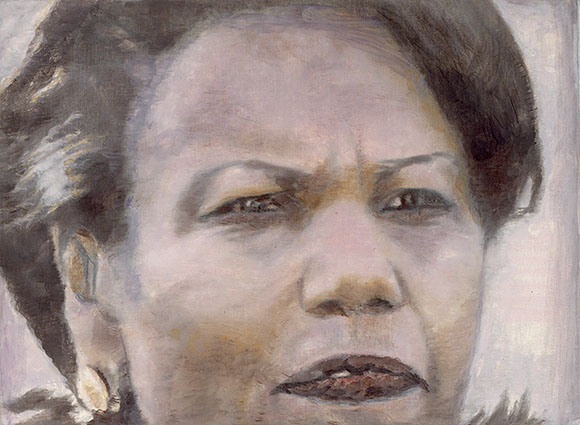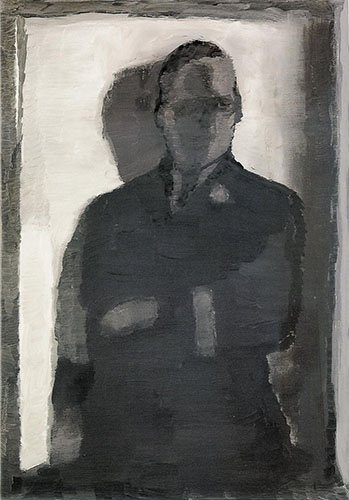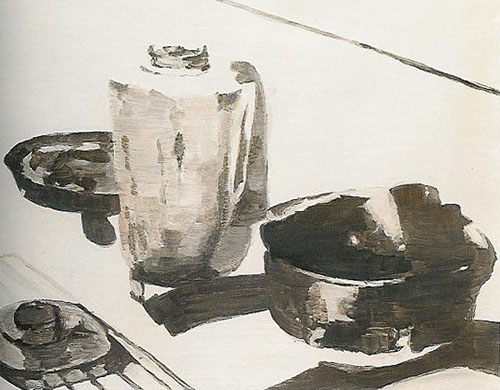 |
Belgian painter Luc Tuymans has breathed new energy into painting by pretending to drain the life out of it. His paintings, which are short on information, long on implication, parade their emptiness. But they also pack a punch. Like a postmodern Marlow, Tuymans plies the river of civilization’s discontents. He’s armed with a paintbrush, but not much hope for humanity.
Tuymans, whose retrospective opened last week at SF MOMA, is a history painter. His paintings of the Holocaust, Flemish nationalism, Belgian colonialism and post-9/11 America are based on photography, television, cinema, and to a lesser extent, on art history. But unlike the artist to which he is most often compared – Gerhard Richter — Tuymans filters his synthesis of art history through his experience making movies. In the 1980s he quit painting for five years and made experimental films that allowed him to find a meaningful way back into his chosen medium. He did this by looking closely at his films’ components parts, reveling in individual frames and barely recognizable artifacts.
 |
That investigation deeply influenced all of his subsequent work, particularly his series about perception, At Random. He has also worked with a Polaroid camera to document his surroundings, relying on the gel of the developing image to inspire paintings that read like murky pools inhabited by ghosts. Equally influential are the photographs he takes of magazines and television images, which he often re-photographs to give himself a working model of how media images remain in memory.
If you feel an icy remove while looking at Tuymans’ paintings, it’s because the subjects themselves are often wrenched out of context. Tuymans’ specialty is the incoherent fragment — a closely cropped image rendered in pale and sometimes putrid color, made indecipherable through a diminished or total absence of almost all of the elements that define a picture.
 |
“This device,” writes co-curator Helen Molesworth, “lends a sick, chemically saturated quality to the palette.” His omission of gloss from his oils further flattens his spatially starved paintings. The result is a confusing, yet oddly compelling mix of painterly clumsiness and pictorial elegance.
Thus, we enter Tuymans’ works through their titles and wall texts, and because those documents often reference horrific events, it is impossible not to look. Once you do you’re caught in a visual-linguistic crossfire — between titles that jolt and paintings that speak in a whisper, and sometimes not even that. (“My paintings are silent,” the artist told a museum lecture audience.) Crudely affixed to their supports and painted quickly and casually, his pictures appear — even when richly hued — to be monochromatic, as if dipped in fog. They are ostensibly representational; yet most of the “facts” — people, buildings, furnishings, and landscapes – are abstract and out-of-focus, like “a videotape paused on a primitive VCR,” Peter Schjeldahl wrote in a New Yorker review of the show after its U.S. tour began last fall at the Wexner Center for the Arts in Columbus. The banal results of this willful obfuscation might lead you to conclude that Tuymans’ paintings are inconsequential. But they are not. Like malicious computer worms, his pictures, once lodged, have a way of invading your brain.
 |
His most controversial and easily most difficult painting, Gas Chamber, is unrecognizable as such. It’s a room with a drain in the center, its fake showerheads represented by inchoate marks. The horror of it doesn’t lie in what actually happened; it’s that such horrors can be depicted so plainly. The Architect, a picture of Albert Speer on skis, is even more anonymous; the face is obliterated, blinded to the havoc wreaked by its owner and, by extension, the Nazi war machine. Similarly, in Reparations, two montages – one of eyes, one of limbs – it’s a wall text that informs us that they are derived from photographs of medical experiments. To look is to assume, in a detached sense, the position of Josef Mengele: that atrocities qualify as medical research.
 |
Our New Quarters is a crude painting of an actual Nazi-era postcard that had those words superimposed on a picture of the Theresienstadt death camp. It was given to prisoners to send home. This re-presented document, likening a concentration camp to a family vacation, sums up as well as anything the sadistic pathology of genocide.
Some observers, including Schjeldahl, have alleged that his choice of subject matter is a ploy to get people to look at his paintings. That may be true in some measure; but it’s no shtick. His family divided over the war: his father’s brothers, one of whom Tuymans is named after, fought with the Nazis and were disowned by the artist’s paternal grandmother after they fled the German army. His wife’s family fought in the resistance and hid Jews. When things got tense around the Tuymans household, the past reared its ugly head.
 |
“In the enigmatic reworking of this banal domestic scene,” writes historian Lanka Tattersall of Peter, “Tuymans ominously undercuts the distinction between generic everyday life and the disquiet of a crime scene.”
That disconnect, between appearance and reality, is, I believe, the true center of Tuymans’ oeuvre. Whether sneering at bourgeoisie social conventions or savaging institutional powers that feed on human suffering, Tuymans is all about exposing horrors that carefully crafted appearances are designed to bury.
–DAVID M. ROTH
Terrific review, David.
History painter sounds just right, but a history painter for the media age. Thanks for the info on his personal history’ his choices of subject matter and treatment seem to flow from that, though he has had the courage not to look away. It would be easy to trivialize or exploit his momentous themes (as Kiefer was once accused of doing, and others, IMHO, have done, all too cynically), but, clearly, Tuymans is for real.
Condi looks a bit like Laura……
Good review….I can’t wait to see the show.